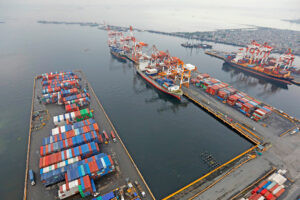




Philippines Trade Update: Trade trajectories trend along
 DOWNLOAD
DOWNLOAD

Policy Rate Updates: Double cut finale
 DOWNLOAD
DOWNLOAD

Monthly Economic Update: One for the road
 DOWNLOAD
DOWNLOAD


November trade gap widens to USD 4.7B

THE PHILIPPINES’ trade-in-goods deficit hit USD 4.69 billion in November, the widest gap in seven months due to flattish import growth and the continued decline in exports amid sluggish global demand.
Preliminary data from the Philippine Statistics Authority (PSA) showed the deficit jumped by 26.3% from the USD 3.72-billion gap a year ago. It was also wider than the revised USD 4.39 billion in October.
November marked the widest trade deficit since the USD 4.84-billion gap in April. The last time the country swung to a trade surplus was in May 2015 with USD 64.95 million.
Merchandise exports contracted by 13.7% to USD 6.13 billion, the third straight month of decline, though slower than the 17.5% drop in October. This was a reversal from the 13.1% growth a year ago.
November also saw the smallest export value since USD 4.9 billion in April.
On the other hand, the value of the country’s import bill inched up 0.02% year on year to USD 10.82 billion.
November saw the first growth in imports after nine straight months of annual decline. The flattish growth was still better than the 2.4% decline in October and the 1.5% drop in November 2022.
The month’s import bill had the biggest value in three months or since the USD 10.83 billion in August.
For January to November, the trade deficit narrowed to USD 48.98 billion from the USD 53.72-billion gap a year earlier.
Exports fell by 8.4% to USD 67.03 billion at end-November, while imports declined by 8.6% to USD 116.01 billion. The government expects exports to have declined by 4% in 2023, and imports to have dropped by 3%.
Analysts attributed the wider trade gap to the continued decline in exports, particularly semiconductors.
In a Viber message, Security Bank Corp. Chief Economist Robert Dan J. Roces said the November data showed the “export slump overshadowing steady imports.”
Outbound sales of manufactured goods, which made up 81.4% of the total exports, sank by 17.5% to USD 4.99 billion.
“Exports declined for the third consecutive month mainly due to the weakness in the sales of semiconductors, the country’s largest export,” China Banking Corp. Chief Economist Domini S. Velasquez said in a separate Viber message.
Electronic products, accounting for the bulk of the manufactured goods and more than half of the total exports, slumped by 24.7% to USD 3.44 billion.
Semiconductors, making up 80% of electronic products and 45.3% of November exports, slid by 25.7% to USD 2.78 billion.
Mr. Roces noted imports were “unexpectedly flat” in November, ending nine straight months of decline.
“Consumer goods accelerated for a second month thanks to holiday spending, while capital goods (+0.1%) were flat, albeit halting seven months of contraction,” he added.
Imports of raw materials and intermediate goods, which accounted for 36.2% of the total import bill, fell by 3.8% to USD 3.92 billion in November.
Mineral fuels, lubricants, and related materials also dropped by 7.8% annually to USD 1.56 billion.
Meanwhile, capital and consumer goods rose by 0.1% and 15.4%, respectively, to USD 3.03 billion and USD 2.27 billion.
The United States was the top destination of locally made products in November with a 16% share worth USD 1.14 billion.
Japan was the Philippines’ second-biggest export trading partner with a 13.2% share worth USD 938.3 million. Exports to China were valued at USD 876.27 million, equivalent to a 12.3% share.
On the other hand, China remained the Philippines’ main source of imported goods with a value of USD 2.6 billion, accounting for 24% of the total. Imports from Indonesia were valued at USD 1.15 billion (10.6% of the total), while imports from Japan reached USD 943.57 million (8.2%).
“Overall, the trade balance remained in substantial deficit. This development suggests that the current account is likewise in shortfall and points to sustained pressure on the peso in the coming months,” Nicholas Antonio T. Mapa, senior economist at ING Bank N.V. Manila, said in a note.
Mr. Roces said the trade deficit likely further widened in the fourth quarter.
“Weaker trade could derail economic growth. The lack of capital goods imports is worrisome given that this is a leading indicator of investments and GDP (gross domestic product) growth. Hopefully, we see this improve this year as the government undertakes more infrastructure projects,” Ms. Velasquez said.
For the first nine months of 2023, Philippine GDP expanded by 5.5%, below the government’s 6-7% full-year target. – Andrea C. Abestano, Researcher
This article originally appeared on bworldonline.com





 By BusinessWorld
By BusinessWorld
